LB5234: Eastern Massachusetts University Hospital GSU Status Report
VerifiedAdded on 2023/03/29
|11
|2211
|51
Report
AI Summary
This report provides a comprehensive status analysis of the General Surgery Unit (GSU) at Eastern Massachusetts University Hospital (EMU). The report highlights critical issues impacting the unit, including staffing shortages, workplace incivility, and concerns about patient safety and quality of care. Key indicators such as staff conflict, lack of teamwork, and limited staff recognition are identified. The report outlines goals for improvement, focusing on fostering collaboration, acknowledging nurses' performance, prioritizing patient-centered care, eliminating favoritism, and enhancing nurses' contributions to decision-making. Strategies include implementing unit meetings, a peer review system, patient safety surveys, and evidence-based practices like the CUSP framework. The report also emphasizes the importance of a transparent review process, a supportive work environment, and promoting positive patient-nurse relationships. The recommendations aim to improve staff satisfaction, enhance patient care, and create a more effective and collaborative work environment within the GSU.
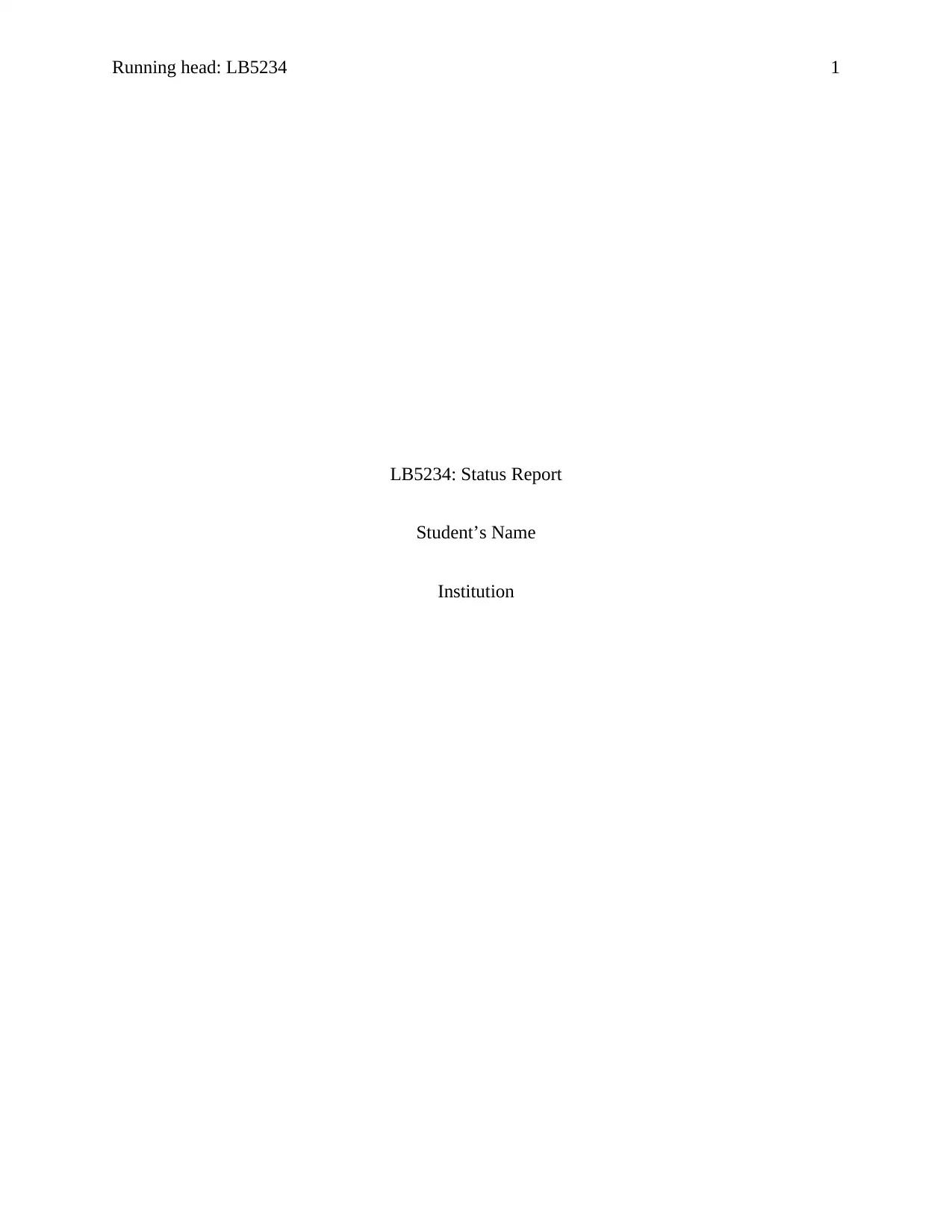
Running head: LB5234 1
LB5234: Status Report
Student’s Name
Institution
LB5234: Status Report
Student’s Name
Institution
Paraphrase This Document
Need a fresh take? Get an instant paraphrase of this document with our AI Paraphraser
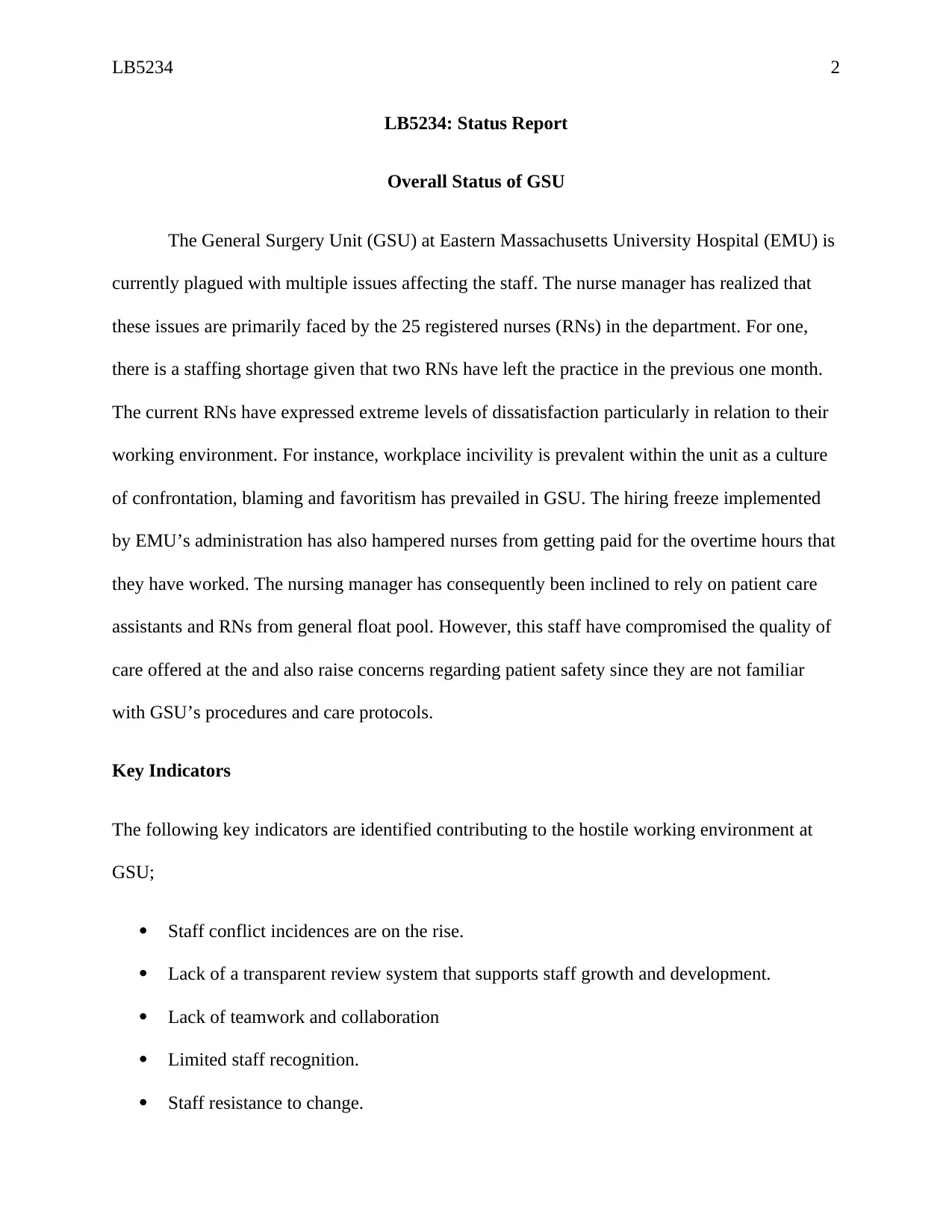
LB5234 2
LB5234: Status Report
Overall Status of GSU
The General Surgery Unit (GSU) at Eastern Massachusetts University Hospital (EMU) is
currently plagued with multiple issues affecting the staff. The nurse manager has realized that
these issues are primarily faced by the 25 registered nurses (RNs) in the department. For one,
there is a staffing shortage given that two RNs have left the practice in the previous one month.
The current RNs have expressed extreme levels of dissatisfaction particularly in relation to their
working environment. For instance, workplace incivility is prevalent within the unit as a culture
of confrontation, blaming and favoritism has prevailed in GSU. The hiring freeze implemented
by EMU’s administration has also hampered nurses from getting paid for the overtime hours that
they have worked. The nursing manager has consequently been inclined to rely on patient care
assistants and RNs from general float pool. However, this staff have compromised the quality of
care offered at the and also raise concerns regarding patient safety since they are not familiar
with GSU’s procedures and care protocols.
Key Indicators
The following key indicators are identified contributing to the hostile working environment at
GSU;
Staff conflict incidences are on the rise.
Lack of a transparent review system that supports staff growth and development.
Lack of teamwork and collaboration
Limited staff recognition.
Staff resistance to change.
LB5234: Status Report
Overall Status of GSU
The General Surgery Unit (GSU) at Eastern Massachusetts University Hospital (EMU) is
currently plagued with multiple issues affecting the staff. The nurse manager has realized that
these issues are primarily faced by the 25 registered nurses (RNs) in the department. For one,
there is a staffing shortage given that two RNs have left the practice in the previous one month.
The current RNs have expressed extreme levels of dissatisfaction particularly in relation to their
working environment. For instance, workplace incivility is prevalent within the unit as a culture
of confrontation, blaming and favoritism has prevailed in GSU. The hiring freeze implemented
by EMU’s administration has also hampered nurses from getting paid for the overtime hours that
they have worked. The nursing manager has consequently been inclined to rely on patient care
assistants and RNs from general float pool. However, this staff have compromised the quality of
care offered at the and also raise concerns regarding patient safety since they are not familiar
with GSU’s procedures and care protocols.
Key Indicators
The following key indicators are identified contributing to the hostile working environment at
GSU;
Staff conflict incidences are on the rise.
Lack of a transparent review system that supports staff growth and development.
Lack of teamwork and collaboration
Limited staff recognition.
Staff resistance to change.
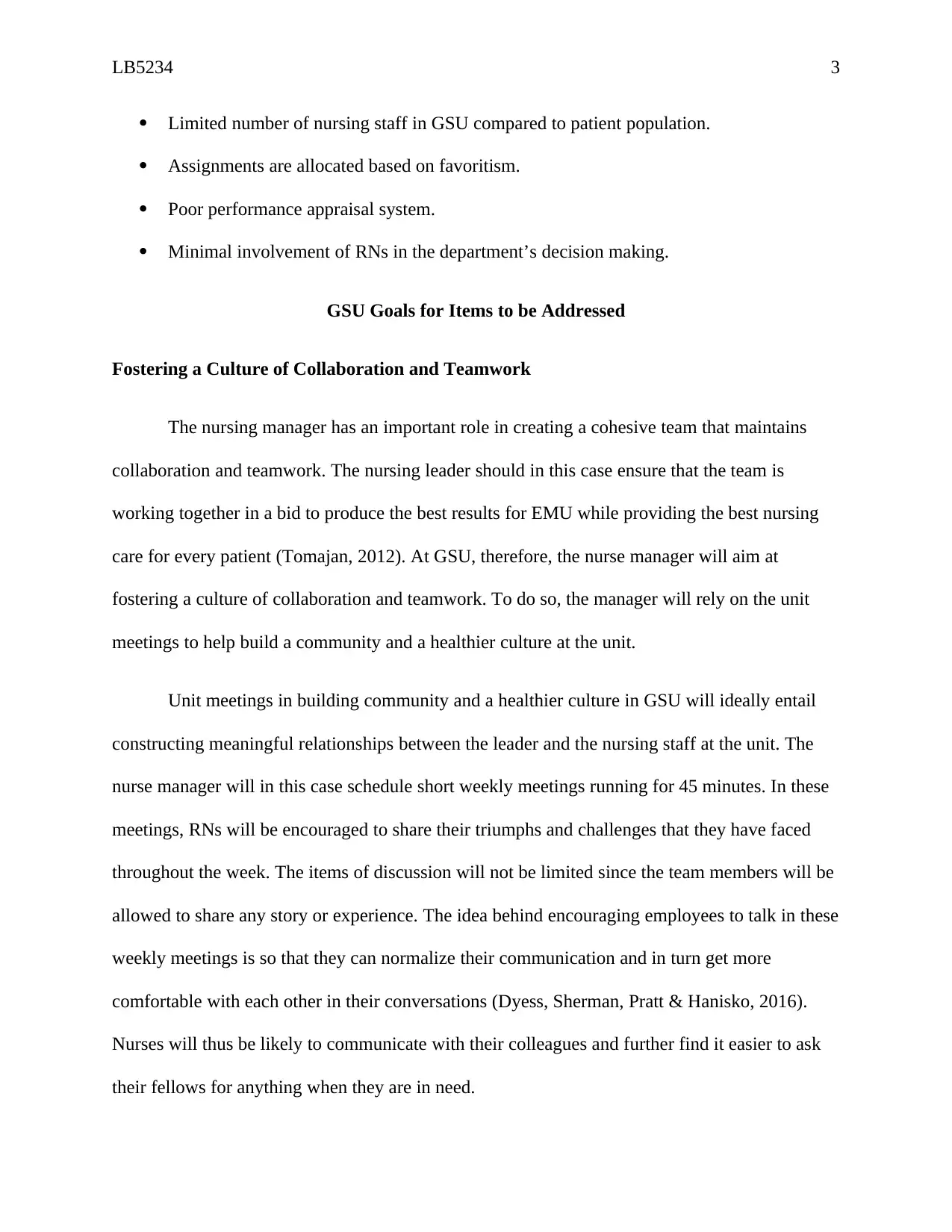
LB5234 3
Limited number of nursing staff in GSU compared to patient population.
Assignments are allocated based on favoritism.
Poor performance appraisal system.
Minimal involvement of RNs in the department’s decision making.
GSU Goals for Items to be Addressed
Fostering a Culture of Collaboration and Teamwork
The nursing manager has an important role in creating a cohesive team that maintains
collaboration and teamwork. The nursing leader should in this case ensure that the team is
working together in a bid to produce the best results for EMU while providing the best nursing
care for every patient (Tomajan, 2012). At GSU, therefore, the nurse manager will aim at
fostering a culture of collaboration and teamwork. To do so, the manager will rely on the unit
meetings to help build a community and a healthier culture at the unit.
Unit meetings in building community and a healthier culture in GSU will ideally entail
constructing meaningful relationships between the leader and the nursing staff at the unit. The
nurse manager will in this case schedule short weekly meetings running for 45 minutes. In these
meetings, RNs will be encouraged to share their triumphs and challenges that they have faced
throughout the week. The items of discussion will not be limited since the team members will be
allowed to share any story or experience. The idea behind encouraging employees to talk in these
weekly meetings is so that they can normalize their communication and in turn get more
comfortable with each other in their conversations (Dyess, Sherman, Pratt & Hanisko, 2016).
Nurses will thus be likely to communicate with their colleagues and further find it easier to ask
their fellows for anything when they are in need.
Limited number of nursing staff in GSU compared to patient population.
Assignments are allocated based on favoritism.
Poor performance appraisal system.
Minimal involvement of RNs in the department’s decision making.
GSU Goals for Items to be Addressed
Fostering a Culture of Collaboration and Teamwork
The nursing manager has an important role in creating a cohesive team that maintains
collaboration and teamwork. The nursing leader should in this case ensure that the team is
working together in a bid to produce the best results for EMU while providing the best nursing
care for every patient (Tomajan, 2012). At GSU, therefore, the nurse manager will aim at
fostering a culture of collaboration and teamwork. To do so, the manager will rely on the unit
meetings to help build a community and a healthier culture at the unit.
Unit meetings in building community and a healthier culture in GSU will ideally entail
constructing meaningful relationships between the leader and the nursing staff at the unit. The
nurse manager will in this case schedule short weekly meetings running for 45 minutes. In these
meetings, RNs will be encouraged to share their triumphs and challenges that they have faced
throughout the week. The items of discussion will not be limited since the team members will be
allowed to share any story or experience. The idea behind encouraging employees to talk in these
weekly meetings is so that they can normalize their communication and in turn get more
comfortable with each other in their conversations (Dyess, Sherman, Pratt & Hanisko, 2016).
Nurses will thus be likely to communicate with their colleagues and further find it easier to ask
their fellows for anything when they are in need.
⊘ This is a preview!⊘
Do you want full access?
Subscribe today to unlock all pages.

Trusted by 1+ million students worldwide
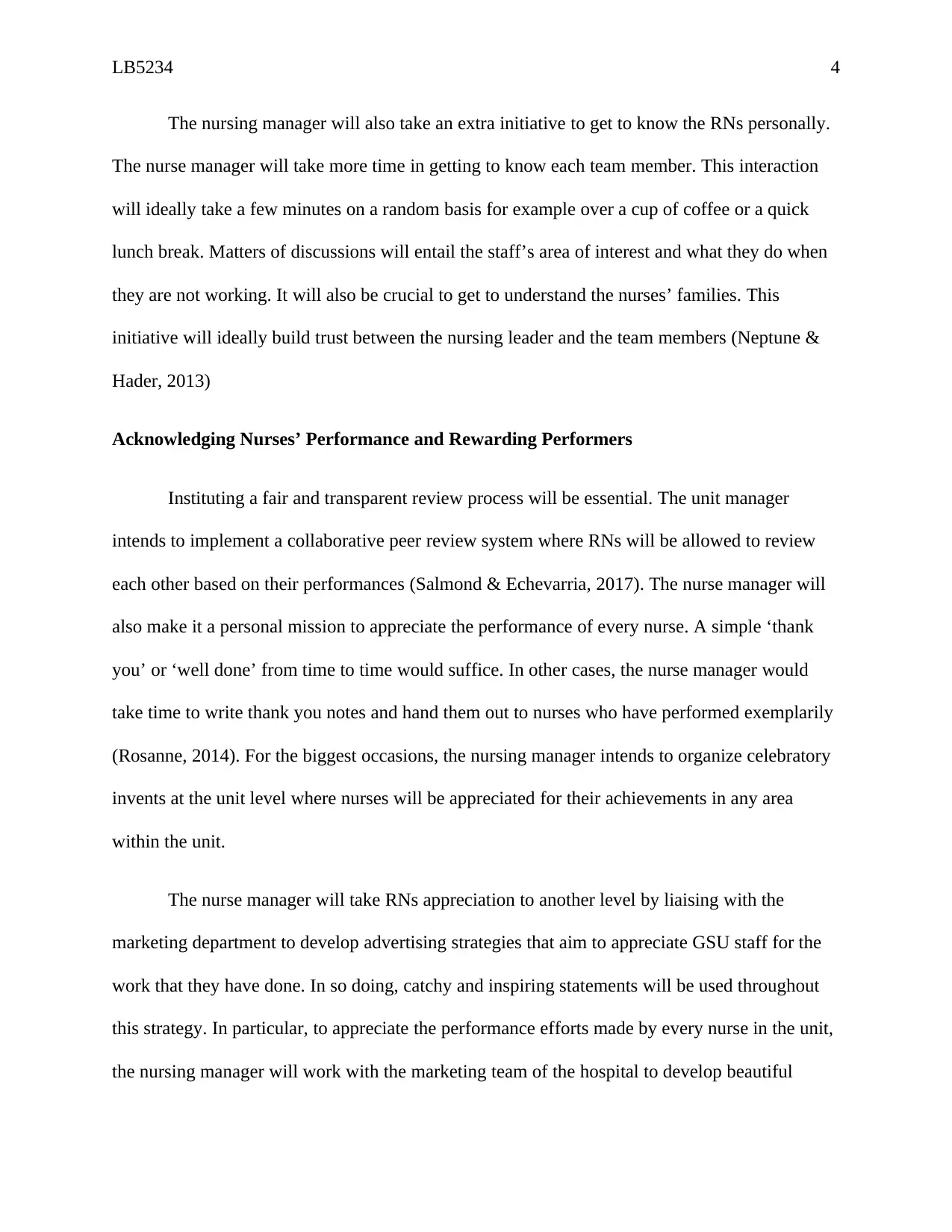
LB5234 4
The nursing manager will also take an extra initiative to get to know the RNs personally.
The nurse manager will take more time in getting to know each team member. This interaction
will ideally take a few minutes on a random basis for example over a cup of coffee or a quick
lunch break. Matters of discussions will entail the staff’s area of interest and what they do when
they are not working. It will also be crucial to get to understand the nurses’ families. This
initiative will ideally build trust between the nursing leader and the team members (Neptune &
Hader, 2013)
Acknowledging Nurses’ Performance and Rewarding Performers
Instituting a fair and transparent review process will be essential. The unit manager
intends to implement a collaborative peer review system where RNs will be allowed to review
each other based on their performances (Salmond & Echevarria, 2017). The nurse manager will
also make it a personal mission to appreciate the performance of every nurse. A simple ‘thank
you’ or ‘well done’ from time to time would suffice. In other cases, the nurse manager would
take time to write thank you notes and hand them out to nurses who have performed exemplarily
(Rosanne, 2014). For the biggest occasions, the nursing manager intends to organize celebratory
invents at the unit level where nurses will be appreciated for their achievements in any area
within the unit.
The nurse manager will take RNs appreciation to another level by liaising with the
marketing department to develop advertising strategies that aim to appreciate GSU staff for the
work that they have done. In so doing, catchy and inspiring statements will be used throughout
this strategy. In particular, to appreciate the performance efforts made by every nurse in the unit,
the nursing manager will work with the marketing team of the hospital to develop beautiful
The nursing manager will also take an extra initiative to get to know the RNs personally.
The nurse manager will take more time in getting to know each team member. This interaction
will ideally take a few minutes on a random basis for example over a cup of coffee or a quick
lunch break. Matters of discussions will entail the staff’s area of interest and what they do when
they are not working. It will also be crucial to get to understand the nurses’ families. This
initiative will ideally build trust between the nursing leader and the team members (Neptune &
Hader, 2013)
Acknowledging Nurses’ Performance and Rewarding Performers
Instituting a fair and transparent review process will be essential. The unit manager
intends to implement a collaborative peer review system where RNs will be allowed to review
each other based on their performances (Salmond & Echevarria, 2017). The nurse manager will
also make it a personal mission to appreciate the performance of every nurse. A simple ‘thank
you’ or ‘well done’ from time to time would suffice. In other cases, the nurse manager would
take time to write thank you notes and hand them out to nurses who have performed exemplarily
(Rosanne, 2014). For the biggest occasions, the nursing manager intends to organize celebratory
invents at the unit level where nurses will be appreciated for their achievements in any area
within the unit.
The nurse manager will take RNs appreciation to another level by liaising with the
marketing department to develop advertising strategies that aim to appreciate GSU staff for the
work that they have done. In so doing, catchy and inspiring statements will be used throughout
this strategy. In particular, to appreciate the performance efforts made by every nurse in the unit,
the nursing manager will work with the marketing team of the hospital to develop beautiful
Paraphrase This Document
Need a fresh take? Get an instant paraphrase of this document with our AI Paraphraser
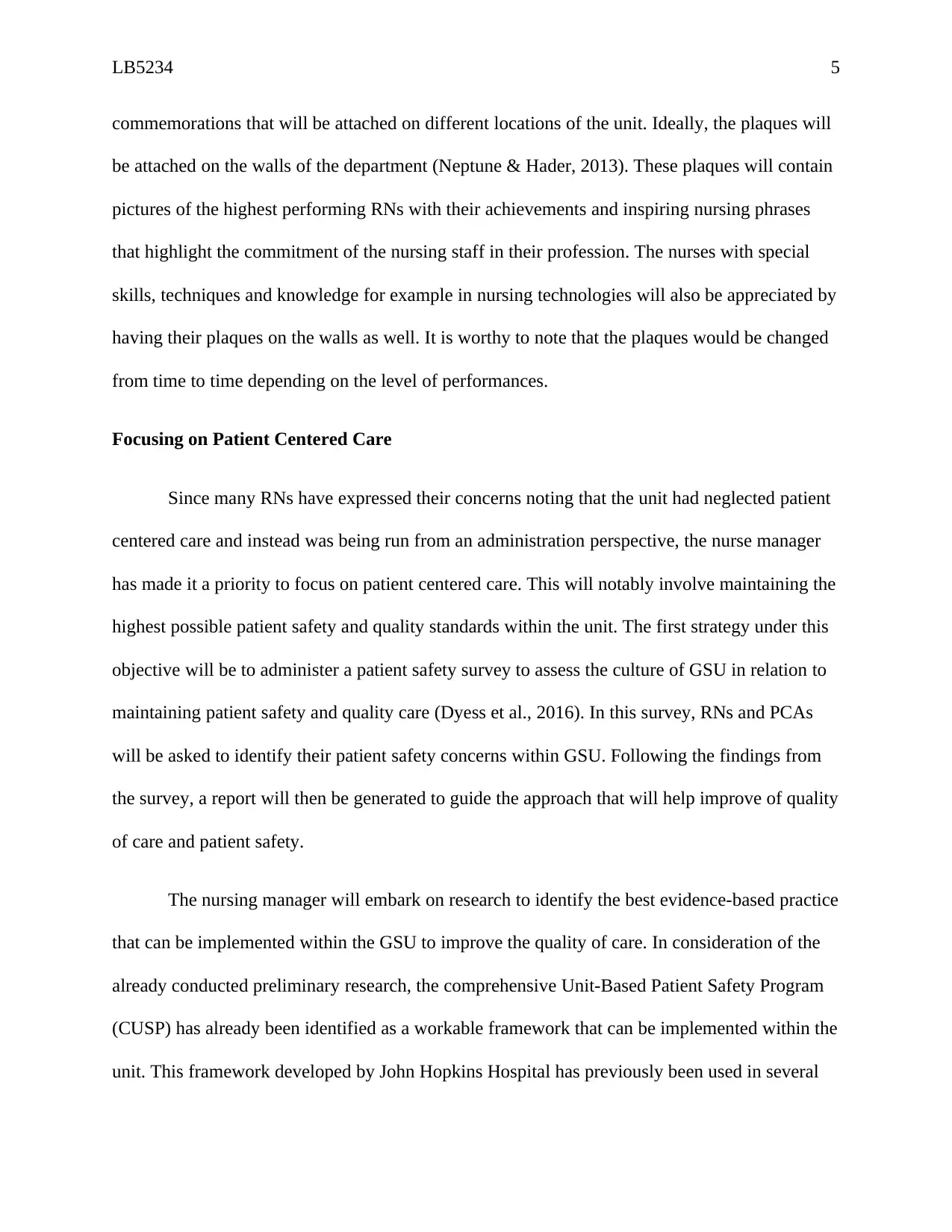
LB5234 5
commemorations that will be attached on different locations of the unit. Ideally, the plaques will
be attached on the walls of the department (Neptune & Hader, 2013). These plaques will contain
pictures of the highest performing RNs with their achievements and inspiring nursing phrases
that highlight the commitment of the nursing staff in their profession. The nurses with special
skills, techniques and knowledge for example in nursing technologies will also be appreciated by
having their plaques on the walls as well. It is worthy to note that the plaques would be changed
from time to time depending on the level of performances.
Focusing on Patient Centered Care
Since many RNs have expressed their concerns noting that the unit had neglected patient
centered care and instead was being run from an administration perspective, the nurse manager
has made it a priority to focus on patient centered care. This will notably involve maintaining the
highest possible patient safety and quality standards within the unit. The first strategy under this
objective will be to administer a patient safety survey to assess the culture of GSU in relation to
maintaining patient safety and quality care (Dyess et al., 2016). In this survey, RNs and PCAs
will be asked to identify their patient safety concerns within GSU. Following the findings from
the survey, a report will then be generated to guide the approach that will help improve of quality
of care and patient safety.
The nursing manager will embark on research to identify the best evidence-based practice
that can be implemented within the GSU to improve the quality of care. In consideration of the
already conducted preliminary research, the comprehensive Unit-Based Patient Safety Program
(CUSP) has already been identified as a workable framework that can be implemented within the
unit. This framework developed by John Hopkins Hospital has previously been used in several
commemorations that will be attached on different locations of the unit. Ideally, the plaques will
be attached on the walls of the department (Neptune & Hader, 2013). These plaques will contain
pictures of the highest performing RNs with their achievements and inspiring nursing phrases
that highlight the commitment of the nursing staff in their profession. The nurses with special
skills, techniques and knowledge for example in nursing technologies will also be appreciated by
having their plaques on the walls as well. It is worthy to note that the plaques would be changed
from time to time depending on the level of performances.
Focusing on Patient Centered Care
Since many RNs have expressed their concerns noting that the unit had neglected patient
centered care and instead was being run from an administration perspective, the nurse manager
has made it a priority to focus on patient centered care. This will notably involve maintaining the
highest possible patient safety and quality standards within the unit. The first strategy under this
objective will be to administer a patient safety survey to assess the culture of GSU in relation to
maintaining patient safety and quality care (Dyess et al., 2016). In this survey, RNs and PCAs
will be asked to identify their patient safety concerns within GSU. Following the findings from
the survey, a report will then be generated to guide the approach that will help improve of quality
of care and patient safety.
The nursing manager will embark on research to identify the best evidence-based practice
that can be implemented within the GSU to improve the quality of care. In consideration of the
already conducted preliminary research, the comprehensive Unit-Based Patient Safety Program
(CUSP) has already been identified as a workable framework that can be implemented within the
unit. This framework developed by John Hopkins Hospital has previously been used in several
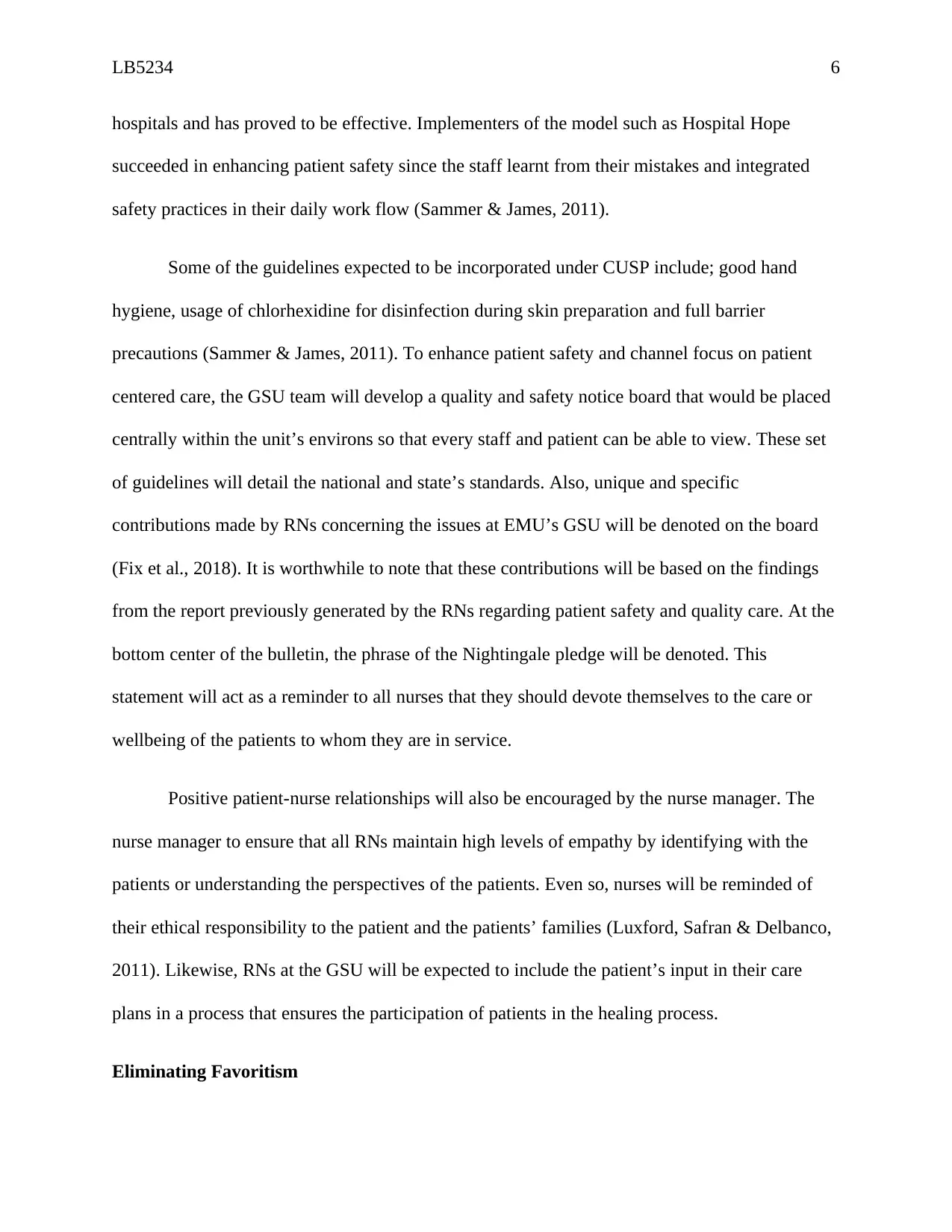
LB5234 6
hospitals and has proved to be effective. Implementers of the model such as Hospital Hope
succeeded in enhancing patient safety since the staff learnt from their mistakes and integrated
safety practices in their daily work flow (Sammer & James, 2011).
Some of the guidelines expected to be incorporated under CUSP include; good hand
hygiene, usage of chlorhexidine for disinfection during skin preparation and full barrier
precautions (Sammer & James, 2011). To enhance patient safety and channel focus on patient
centered care, the GSU team will develop a quality and safety notice board that would be placed
centrally within the unit’s environs so that every staff and patient can be able to view. These set
of guidelines will detail the national and state’s standards. Also, unique and specific
contributions made by RNs concerning the issues at EMU’s GSU will be denoted on the board
(Fix et al., 2018). It is worthwhile to note that these contributions will be based on the findings
from the report previously generated by the RNs regarding patient safety and quality care. At the
bottom center of the bulletin, the phrase of the Nightingale pledge will be denoted. This
statement will act as a reminder to all nurses that they should devote themselves to the care or
wellbeing of the patients to whom they are in service.
Positive patient-nurse relationships will also be encouraged by the nurse manager. The
nurse manager to ensure that all RNs maintain high levels of empathy by identifying with the
patients or understanding the perspectives of the patients. Even so, nurses will be reminded of
their ethical responsibility to the patient and the patients’ families (Luxford, Safran & Delbanco,
2011). Likewise, RNs at the GSU will be expected to include the patient’s input in their care
plans in a process that ensures the participation of patients in the healing process.
Eliminating Favoritism
hospitals and has proved to be effective. Implementers of the model such as Hospital Hope
succeeded in enhancing patient safety since the staff learnt from their mistakes and integrated
safety practices in their daily work flow (Sammer & James, 2011).
Some of the guidelines expected to be incorporated under CUSP include; good hand
hygiene, usage of chlorhexidine for disinfection during skin preparation and full barrier
precautions (Sammer & James, 2011). To enhance patient safety and channel focus on patient
centered care, the GSU team will develop a quality and safety notice board that would be placed
centrally within the unit’s environs so that every staff and patient can be able to view. These set
of guidelines will detail the national and state’s standards. Also, unique and specific
contributions made by RNs concerning the issues at EMU’s GSU will be denoted on the board
(Fix et al., 2018). It is worthwhile to note that these contributions will be based on the findings
from the report previously generated by the RNs regarding patient safety and quality care. At the
bottom center of the bulletin, the phrase of the Nightingale pledge will be denoted. This
statement will act as a reminder to all nurses that they should devote themselves to the care or
wellbeing of the patients to whom they are in service.
Positive patient-nurse relationships will also be encouraged by the nurse manager. The
nurse manager to ensure that all RNs maintain high levels of empathy by identifying with the
patients or understanding the perspectives of the patients. Even so, nurses will be reminded of
their ethical responsibility to the patient and the patients’ families (Luxford, Safran & Delbanco,
2011). Likewise, RNs at the GSU will be expected to include the patient’s input in their care
plans in a process that ensures the participation of patients in the healing process.
Eliminating Favoritism
⊘ This is a preview!⊘
Do you want full access?
Subscribe today to unlock all pages.

Trusted by 1+ million students worldwide
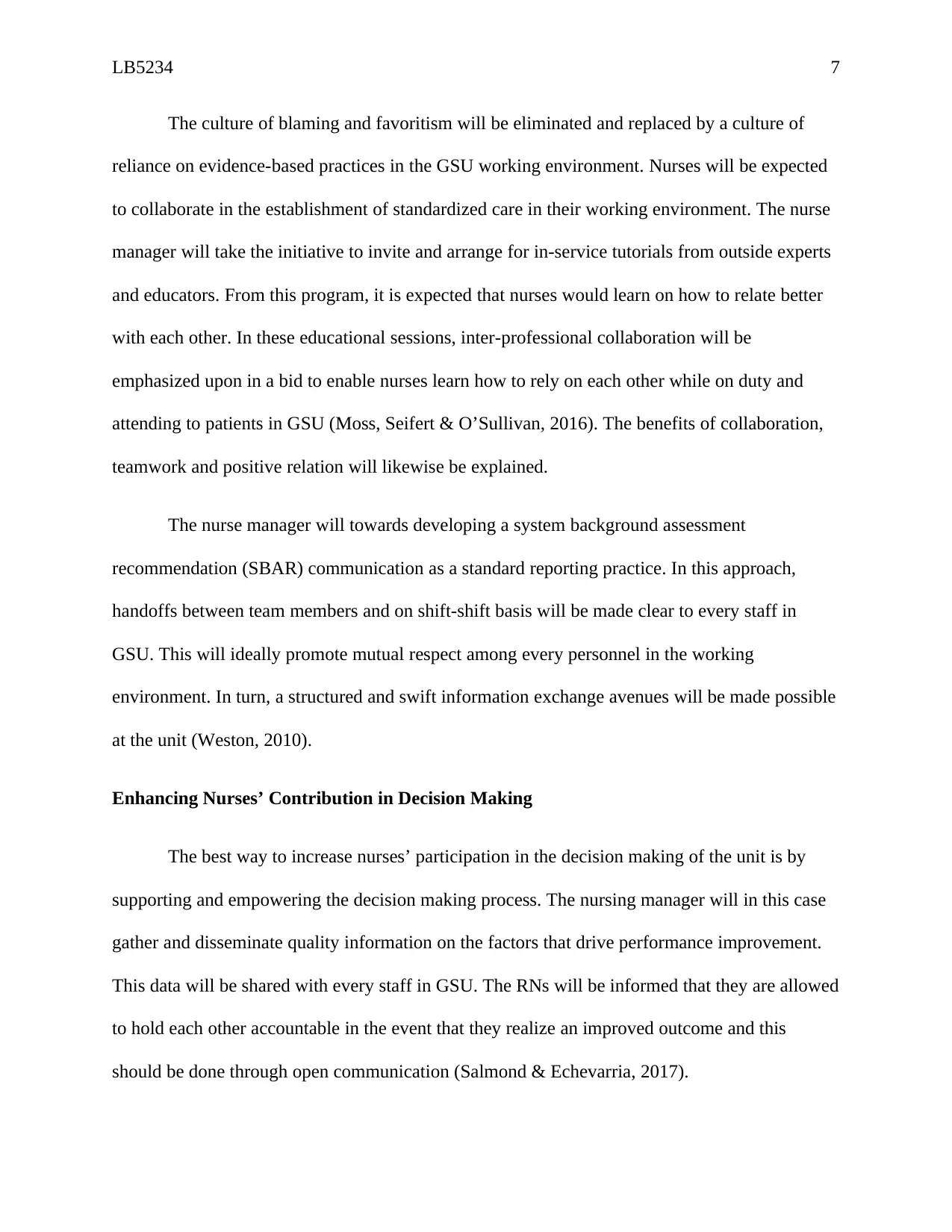
LB5234 7
The culture of blaming and favoritism will be eliminated and replaced by a culture of
reliance on evidence-based practices in the GSU working environment. Nurses will be expected
to collaborate in the establishment of standardized care in their working environment. The nurse
manager will take the initiative to invite and arrange for in-service tutorials from outside experts
and educators. From this program, it is expected that nurses would learn on how to relate better
with each other. In these educational sessions, inter-professional collaboration will be
emphasized upon in a bid to enable nurses learn how to rely on each other while on duty and
attending to patients in GSU (Moss, Seifert & O’Sullivan, 2016). The benefits of collaboration,
teamwork and positive relation will likewise be explained.
The nurse manager will towards developing a system background assessment
recommendation (SBAR) communication as a standard reporting practice. In this approach,
handoffs between team members and on shift-shift basis will be made clear to every staff in
GSU. This will ideally promote mutual respect among every personnel in the working
environment. In turn, a structured and swift information exchange avenues will be made possible
at the unit (Weston, 2010).
Enhancing Nurses’ Contribution in Decision Making
The best way to increase nurses’ participation in the decision making of the unit is by
supporting and empowering the decision making process. The nursing manager will in this case
gather and disseminate quality information on the factors that drive performance improvement.
This data will be shared with every staff in GSU. The RNs will be informed that they are allowed
to hold each other accountable in the event that they realize an improved outcome and this
should be done through open communication (Salmond & Echevarria, 2017).
The culture of blaming and favoritism will be eliminated and replaced by a culture of
reliance on evidence-based practices in the GSU working environment. Nurses will be expected
to collaborate in the establishment of standardized care in their working environment. The nurse
manager will take the initiative to invite and arrange for in-service tutorials from outside experts
and educators. From this program, it is expected that nurses would learn on how to relate better
with each other. In these educational sessions, inter-professional collaboration will be
emphasized upon in a bid to enable nurses learn how to rely on each other while on duty and
attending to patients in GSU (Moss, Seifert & O’Sullivan, 2016). The benefits of collaboration,
teamwork and positive relation will likewise be explained.
The nurse manager will towards developing a system background assessment
recommendation (SBAR) communication as a standard reporting practice. In this approach,
handoffs between team members and on shift-shift basis will be made clear to every staff in
GSU. This will ideally promote mutual respect among every personnel in the working
environment. In turn, a structured and swift information exchange avenues will be made possible
at the unit (Weston, 2010).
Enhancing Nurses’ Contribution in Decision Making
The best way to increase nurses’ participation in the decision making of the unit is by
supporting and empowering the decision making process. The nursing manager will in this case
gather and disseminate quality information on the factors that drive performance improvement.
This data will be shared with every staff in GSU. The RNs will be informed that they are allowed
to hold each other accountable in the event that they realize an improved outcome and this
should be done through open communication (Salmond & Echevarria, 2017).
Paraphrase This Document
Need a fresh take? Get an instant paraphrase of this document with our AI Paraphraser
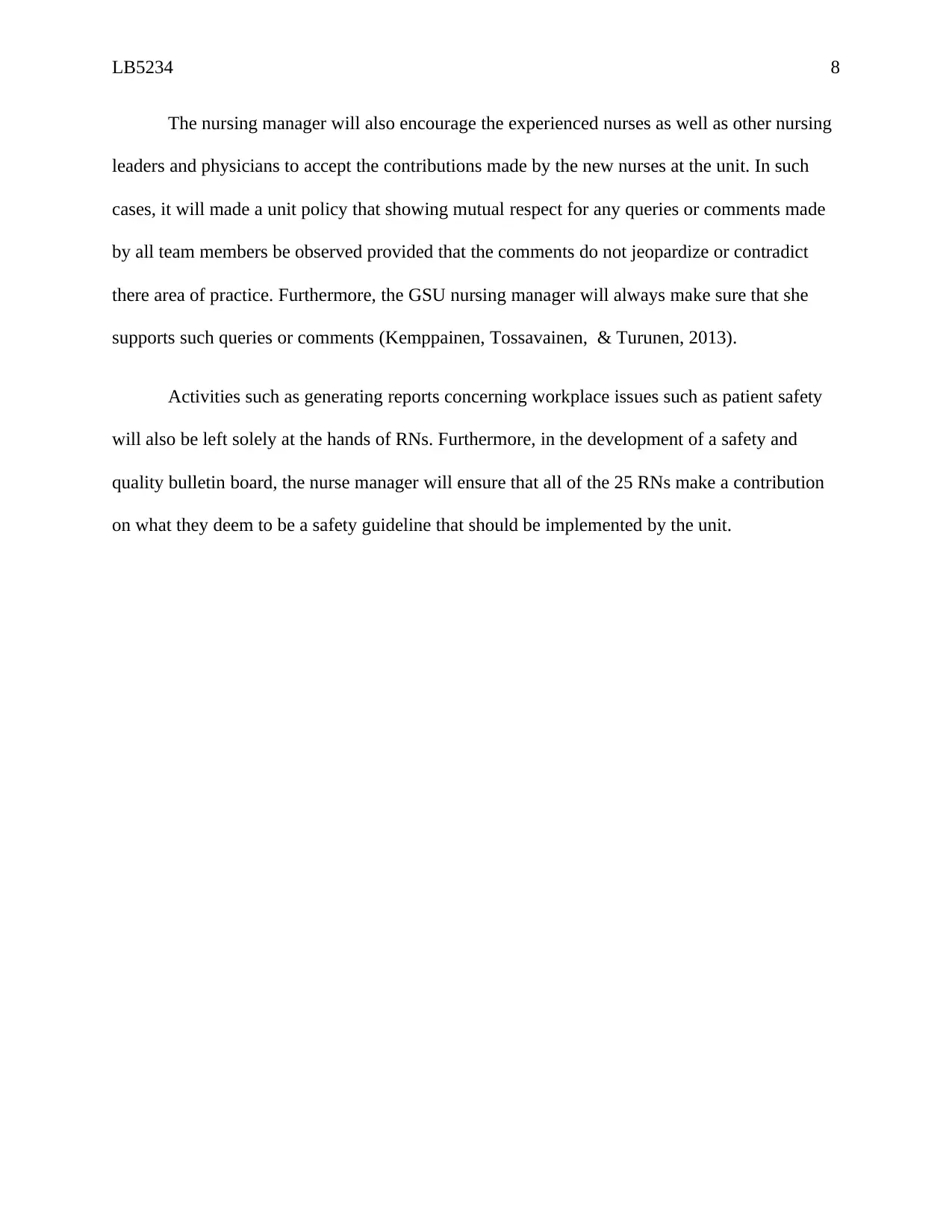
LB5234 8
The nursing manager will also encourage the experienced nurses as well as other nursing
leaders and physicians to accept the contributions made by the new nurses at the unit. In such
cases, it will made a unit policy that showing mutual respect for any queries or comments made
by all team members be observed provided that the comments do not jeopardize or contradict
there area of practice. Furthermore, the GSU nursing manager will always make sure that she
supports such queries or comments (Kemppainen, Tossavainen, & Turunen, 2013).
Activities such as generating reports concerning workplace issues such as patient safety
will also be left solely at the hands of RNs. Furthermore, in the development of a safety and
quality bulletin board, the nurse manager will ensure that all of the 25 RNs make a contribution
on what they deem to be a safety guideline that should be implemented by the unit.
The nursing manager will also encourage the experienced nurses as well as other nursing
leaders and physicians to accept the contributions made by the new nurses at the unit. In such
cases, it will made a unit policy that showing mutual respect for any queries or comments made
by all team members be observed provided that the comments do not jeopardize or contradict
there area of practice. Furthermore, the GSU nursing manager will always make sure that she
supports such queries or comments (Kemppainen, Tossavainen, & Turunen, 2013).
Activities such as generating reports concerning workplace issues such as patient safety
will also be left solely at the hands of RNs. Furthermore, in the development of a safety and
quality bulletin board, the nurse manager will ensure that all of the 25 RNs make a contribution
on what they deem to be a safety guideline that should be implemented by the unit.
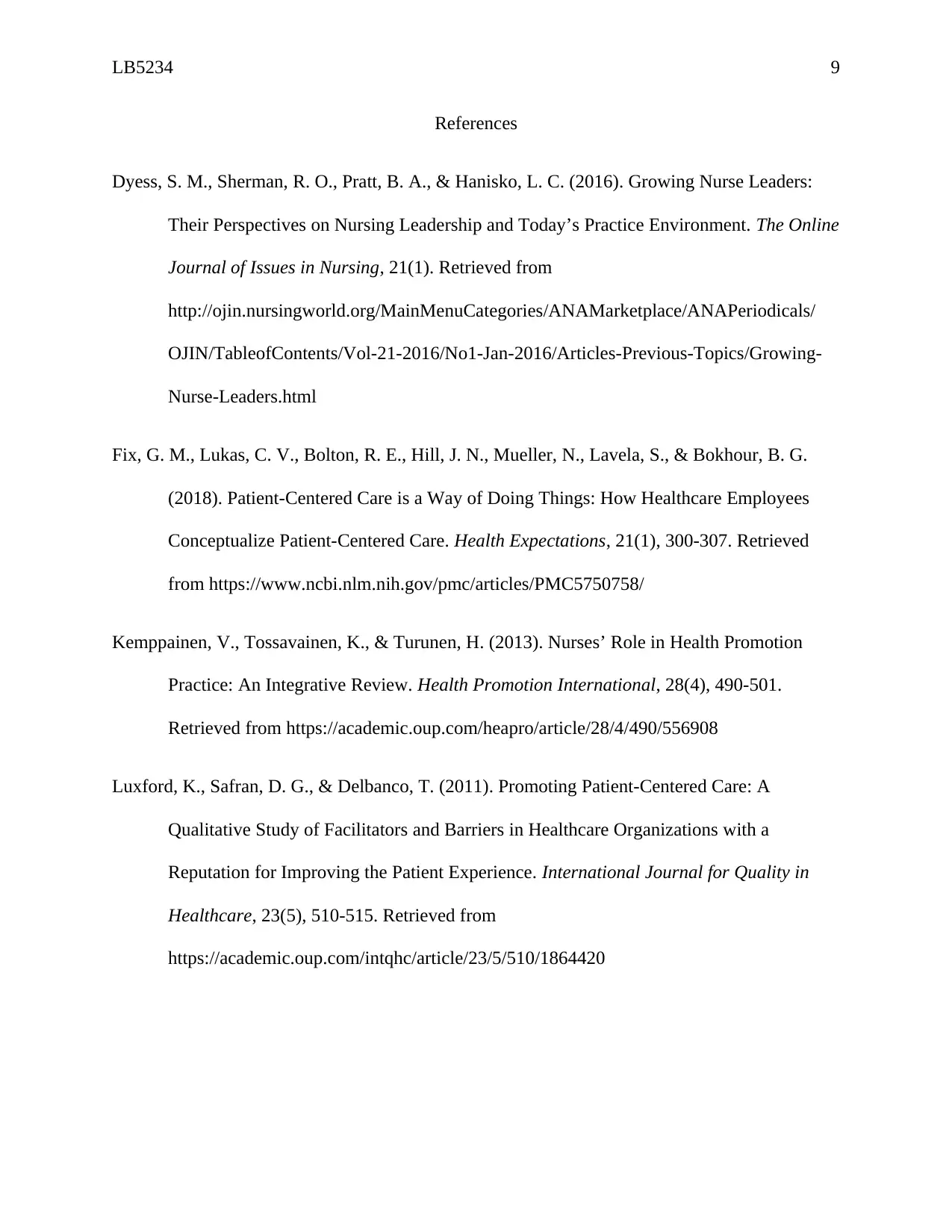
LB5234 9
References
Dyess, S. M., Sherman, R. O., Pratt, B. A., & Hanisko, L. C. (2016). Growing Nurse Leaders:
Their Perspectives on Nursing Leadership and Today’s Practice Environment. The Online
Journal of Issues in Nursing, 21(1). Retrieved from
http://ojin.nursingworld.org/MainMenuCategories/ANAMarketplace/ANAPeriodicals/
OJIN/TableofContents/Vol-21-2016/No1-Jan-2016/Articles-Previous-Topics/Growing-
Nurse-Leaders.html
Fix, G. M., Lukas, C. V., Bolton, R. E., Hill, J. N., Mueller, N., Lavela, S., & Bokhour, B. G.
(2018). Patient-Centered Care is a Way of Doing Things: How Healthcare Employees
Conceptualize Patient-Centered Care. Health Expectations, 21(1), 300-307. Retrieved
from https://www.ncbi.nlm.nih.gov/pmc/articles/PMC5750758/
Kemppainen, V., Tossavainen, K., & Turunen, H. (2013). Nurses’ Role in Health Promotion
Practice: An Integrative Review. Health Promotion International, 28(4), 490-501.
Retrieved from https://academic.oup.com/heapro/article/28/4/490/556908
Luxford, K., Safran, D. G., & Delbanco, T. (2011). Promoting Patient-Centered Care: A
Qualitative Study of Facilitators and Barriers in Healthcare Organizations with a
Reputation for Improving the Patient Experience. International Journal for Quality in
Healthcare, 23(5), 510-515. Retrieved from
https://academic.oup.com/intqhc/article/23/5/510/1864420
References
Dyess, S. M., Sherman, R. O., Pratt, B. A., & Hanisko, L. C. (2016). Growing Nurse Leaders:
Their Perspectives on Nursing Leadership and Today’s Practice Environment. The Online
Journal of Issues in Nursing, 21(1). Retrieved from
http://ojin.nursingworld.org/MainMenuCategories/ANAMarketplace/ANAPeriodicals/
OJIN/TableofContents/Vol-21-2016/No1-Jan-2016/Articles-Previous-Topics/Growing-
Nurse-Leaders.html
Fix, G. M., Lukas, C. V., Bolton, R. E., Hill, J. N., Mueller, N., Lavela, S., & Bokhour, B. G.
(2018). Patient-Centered Care is a Way of Doing Things: How Healthcare Employees
Conceptualize Patient-Centered Care. Health Expectations, 21(1), 300-307. Retrieved
from https://www.ncbi.nlm.nih.gov/pmc/articles/PMC5750758/
Kemppainen, V., Tossavainen, K., & Turunen, H. (2013). Nurses’ Role in Health Promotion
Practice: An Integrative Review. Health Promotion International, 28(4), 490-501.
Retrieved from https://academic.oup.com/heapro/article/28/4/490/556908
Luxford, K., Safran, D. G., & Delbanco, T. (2011). Promoting Patient-Centered Care: A
Qualitative Study of Facilitators and Barriers in Healthcare Organizations with a
Reputation for Improving the Patient Experience. International Journal for Quality in
Healthcare, 23(5), 510-515. Retrieved from
https://academic.oup.com/intqhc/article/23/5/510/1864420
⊘ This is a preview!⊘
Do you want full access?
Subscribe today to unlock all pages.

Trusted by 1+ million students worldwide
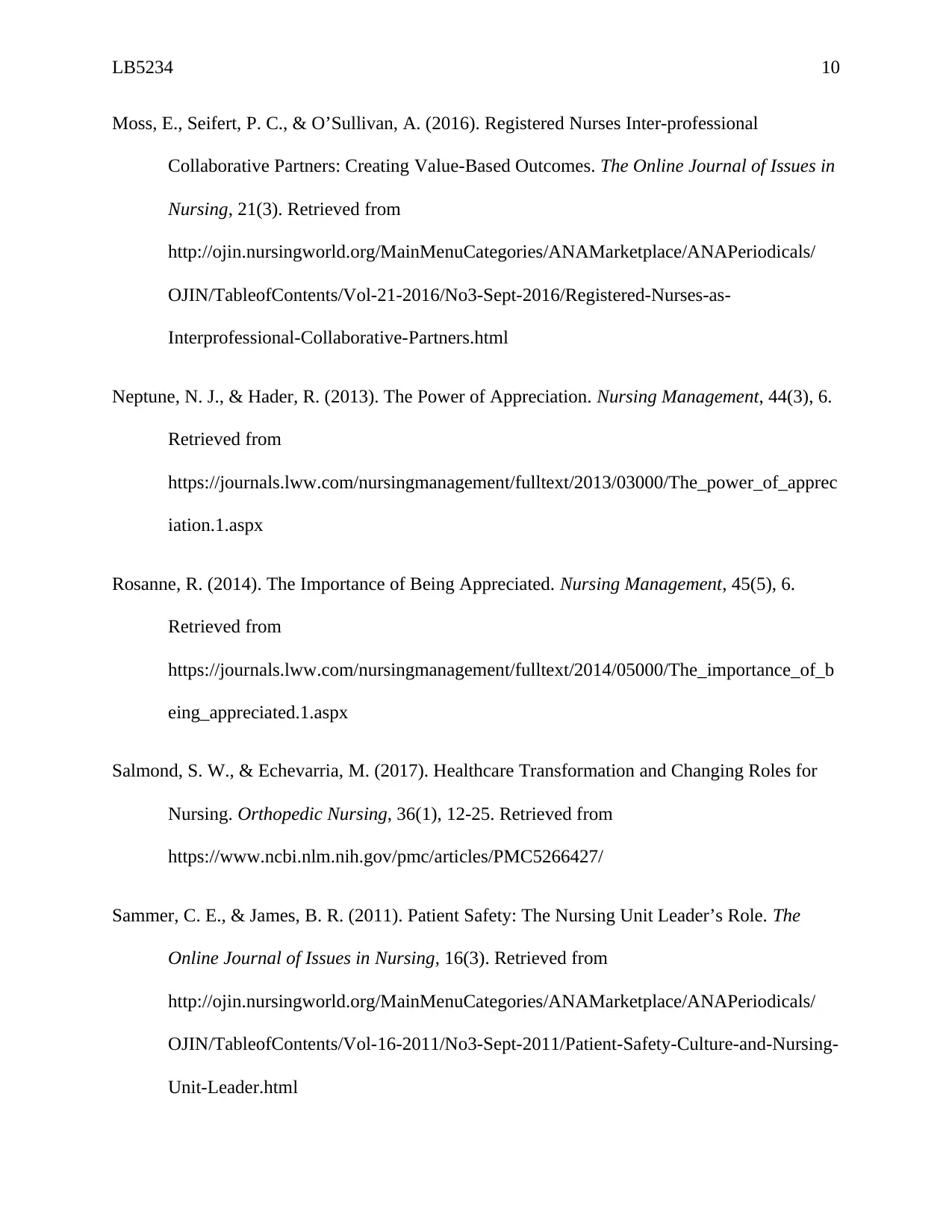
LB5234 10
Moss, E., Seifert, P. C., & O’Sullivan, A. (2016). Registered Nurses Inter-professional
Collaborative Partners: Creating Value-Based Outcomes. The Online Journal of Issues in
Nursing, 21(3). Retrieved from
http://ojin.nursingworld.org/MainMenuCategories/ANAMarketplace/ANAPeriodicals/
OJIN/TableofContents/Vol-21-2016/No3-Sept-2016/Registered-Nurses-as-
Interprofessional-Collaborative-Partners.html
Neptune, N. J., & Hader, R. (2013). The Power of Appreciation. Nursing Management, 44(3), 6.
Retrieved from
https://journals.lww.com/nursingmanagement/fulltext/2013/03000/The_power_of_apprec
iation.1.aspx
Rosanne, R. (2014). The Importance of Being Appreciated. Nursing Management, 45(5), 6.
Retrieved from
https://journals.lww.com/nursingmanagement/fulltext/2014/05000/The_importance_of_b
eing_appreciated.1.aspx
Salmond, S. W., & Echevarria, M. (2017). Healthcare Transformation and Changing Roles for
Nursing. Orthopedic Nursing, 36(1), 12-25. Retrieved from
https://www.ncbi.nlm.nih.gov/pmc/articles/PMC5266427/
Sammer, C. E., & James, B. R. (2011). Patient Safety: The Nursing Unit Leader’s Role. The
Online Journal of Issues in Nursing, 16(3). Retrieved from
http://ojin.nursingworld.org/MainMenuCategories/ANAMarketplace/ANAPeriodicals/
OJIN/TableofContents/Vol-16-2011/No3-Sept-2011/Patient-Safety-Culture-and-Nursing-
Unit-Leader.html
Moss, E., Seifert, P. C., & O’Sullivan, A. (2016). Registered Nurses Inter-professional
Collaborative Partners: Creating Value-Based Outcomes. The Online Journal of Issues in
Nursing, 21(3). Retrieved from
http://ojin.nursingworld.org/MainMenuCategories/ANAMarketplace/ANAPeriodicals/
OJIN/TableofContents/Vol-21-2016/No3-Sept-2016/Registered-Nurses-as-
Interprofessional-Collaborative-Partners.html
Neptune, N. J., & Hader, R. (2013). The Power of Appreciation. Nursing Management, 44(3), 6.
Retrieved from
https://journals.lww.com/nursingmanagement/fulltext/2013/03000/The_power_of_apprec
iation.1.aspx
Rosanne, R. (2014). The Importance of Being Appreciated. Nursing Management, 45(5), 6.
Retrieved from
https://journals.lww.com/nursingmanagement/fulltext/2014/05000/The_importance_of_b
eing_appreciated.1.aspx
Salmond, S. W., & Echevarria, M. (2017). Healthcare Transformation and Changing Roles for
Nursing. Orthopedic Nursing, 36(1), 12-25. Retrieved from
https://www.ncbi.nlm.nih.gov/pmc/articles/PMC5266427/
Sammer, C. E., & James, B. R. (2011). Patient Safety: The Nursing Unit Leader’s Role. The
Online Journal of Issues in Nursing, 16(3). Retrieved from
http://ojin.nursingworld.org/MainMenuCategories/ANAMarketplace/ANAPeriodicals/
OJIN/TableofContents/Vol-16-2011/No3-Sept-2011/Patient-Safety-Culture-and-Nursing-
Unit-Leader.html
Paraphrase This Document
Need a fresh take? Get an instant paraphrase of this document with our AI Paraphraser
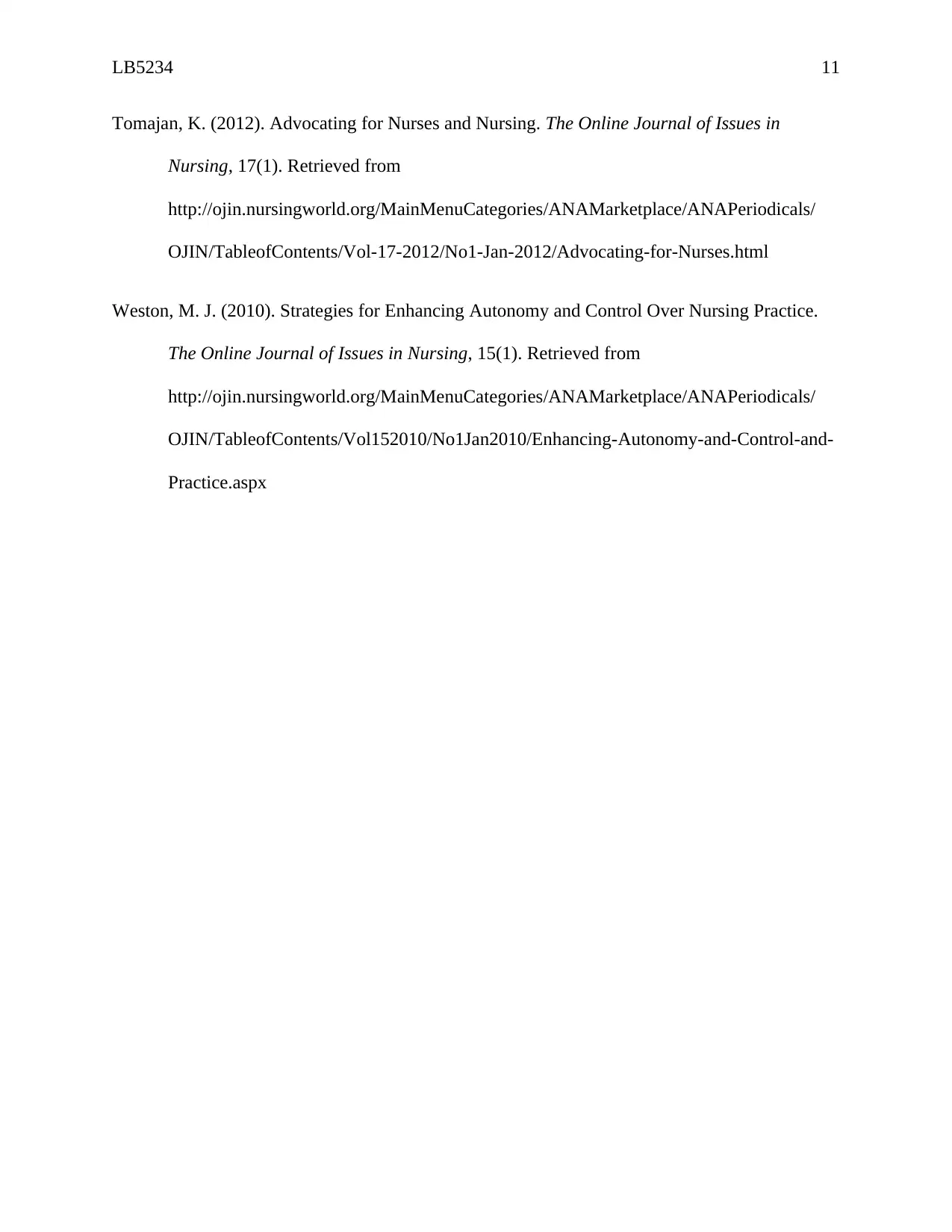
LB5234 11
Tomajan, K. (2012). Advocating for Nurses and Nursing. The Online Journal of Issues in
Nursing, 17(1). Retrieved from
http://ojin.nursingworld.org/MainMenuCategories/ANAMarketplace/ANAPeriodicals/
OJIN/TableofContents/Vol-17-2012/No1-Jan-2012/Advocating-for-Nurses.html
Weston, M. J. (2010). Strategies for Enhancing Autonomy and Control Over Nursing Practice.
The Online Journal of Issues in Nursing, 15(1). Retrieved from
http://ojin.nursingworld.org/MainMenuCategories/ANAMarketplace/ANAPeriodicals/
OJIN/TableofContents/Vol152010/No1Jan2010/Enhancing-Autonomy-and-Control-and-
Practice.aspx
Tomajan, K. (2012). Advocating for Nurses and Nursing. The Online Journal of Issues in
Nursing, 17(1). Retrieved from
http://ojin.nursingworld.org/MainMenuCategories/ANAMarketplace/ANAPeriodicals/
OJIN/TableofContents/Vol-17-2012/No1-Jan-2012/Advocating-for-Nurses.html
Weston, M. J. (2010). Strategies for Enhancing Autonomy and Control Over Nursing Practice.
The Online Journal of Issues in Nursing, 15(1). Retrieved from
http://ojin.nursingworld.org/MainMenuCategories/ANAMarketplace/ANAPeriodicals/
OJIN/TableofContents/Vol152010/No1Jan2010/Enhancing-Autonomy-and-Control-and-
Practice.aspx
1 out of 11
Related Documents
Your All-in-One AI-Powered Toolkit for Academic Success.
+13062052269
info@desklib.com
Available 24*7 on WhatsApp / Email
![[object Object]](/_next/static/media/star-bottom.7253800d.svg)
Unlock your academic potential
Copyright © 2020–2025 A2Z Services. All Rights Reserved. Developed and managed by ZUCOL.





